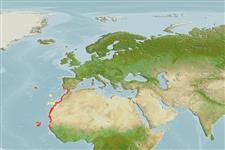>
Eupercaria/misc (Various families in series Eupercaria) >
Sparidae (Porgies)
Etymology: Diplodus: Greek, diploos = twice + Greek, odous = teeth (Ref. 45335).
Eponymy: Cristoforo Bellotti (1823–1919) was an Italian ichthyologist and palaeontologist, who was also very interested in the breeding of silkworms. [...] (Ref. 128868), visit book page.
More on author: Steindachner.
Environment: milieu / climate zone / profondeur / distribution range
Écologie
marin benthopélagique; profondeur 0 - 100 m (Ref. 3688), usually 30 - 50 m (Ref. 2683). Subtropical; 38°N - 13°N, 27°W - 5°W
Southwestern Mediterranean Sea (Malaga to Gibraltar); eastern Atlantic from Cape Verde Islands north to Cadiz (Spain).
Length at first maturity / Taille / Poids / Âge
Maturité: Lm 11.4 range ? - ? cm
Max length : 30.0 cm SL mâle / non sexé; (Ref. 4781); common length : 15.0 cm SL mâle / non sexé; (Ref. 4781)
Description synthétique
Clés d'identification | Morphologie | Morphométrie
Épines dorsales (Total) : 10 - 11; Rayons mous dorsaux (Total) : 13 - 15; Épines anales: 3; Rayons mous anaux: 13 - 15.
Body shape (shape guide): fusiform / normal; Cross section: compressed.
Gregarious. Inhabits the upper portion of the continental shelf from the coastline to 100 m depth, but especially from 30 to 50 m. Occurs on various types of bottom. Sometimes forms sizeable aggregations. Feeds on small benthic mollusks and crustaceans (Ref. 4781). Important food fish. Minimum depth range from Ref. 113561.
Life cycle and mating behavior
Maturité | Reproduction | Frai | Œufs | Fécondité | Larves
Bauchot, M.-L. and J.-C. Hureau, 1990. Sparidae. p. 790-812. In J.C. Quero, J.C. Hureau, C. Karrer, A. Post and L. Saldanha (eds.) Check-list of the fishes of the eastern tropical Atlantic (CLOFETA). JNICT, Lisbon; SEI, Paris; and UNESCO, Paris. Vol. 2. (Ref. 3688)
Statut dans la liste rouge de l'IUCN (Ref. 130435: Version 2025-1)
Menace pour l'homme
Harmless
Utilisations par l'homme
Pêcheries: commercial
Outils
Articles particuliers
Télécharger en XML
Sources Internet
Estimates based on models
Preferred temperature (Réf.
123201): 17.6 - 21.6, mean 18.9 °C (based on 14 cells).
Phylogenetic diversity index (Réf.
82804): PD
50 = 0.5000 [Uniqueness, from 0.5 = low to 2.0 = high].
Bayesian length-weight: a=0.01413 (0.01204 - 0.01657), b=3.05 (3.02 - 3.08), in cm total length, based on LWR estimates for this species (Ref.
93245).
Niveau trophique (Réf.
69278): 3.6 ±0.50 se; based on food items.
Generation time: 4.1 ( na - na) years. Estimated as median ln(3)/K based on 1
growth studies.
Résilience (Réf.
120179): Milieu, temps minimum de doublement de population : 1,4 à 4,4 années (K=0.27).
Fishing Vulnerability (Ref.
59153): Moderate vulnerability (36 of 100).
🛈
Nutrients (Ref.
124155): Calcium = 73.9 [41.1, 137.5] mg/100g; Iron = 0.919 [0.517, 1.590] mg/100g; Protein = 19 [18, 20] %; Omega3 = 0.383 [0.212, 0.707] g/100g; Selenium = 24.7 [12.2, 46.5] μg/100g; VitaminA = 24.2 [7.3, 76.6] μg/100g; Zinc = 0.892 [0.629, 1.278] mg/100g (wet weight);
